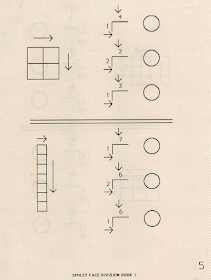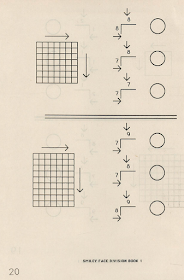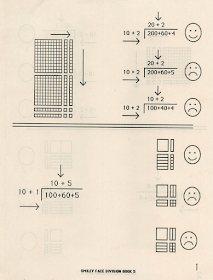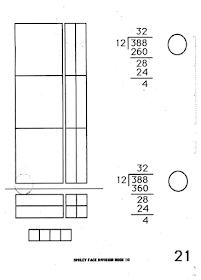You don't have to teach division last you can teach it first if you want AND you can use it to teach subtraction and multiplication. Conventional wisdom is you have to know how to multiply and subtract to learn the algorithm for division.
Face it. Kids hate long division. They hate it for a lot of reasons. They haven't mastered multiplication; they don't like subtraction because counting backwards can pose challenges they aren't sure where to start counting. Manipulatives and the concept based base ten block methodology erase all of that. Mortensen Math rocks.
As you can see this is edited a little, the whole thing is available HERE. Only about 5 or 6 minutes is missing, the part covering negative polynomial division.
Here is a follow up video:
Between these to videos, the division page at the hous of math and this blogpost
http://crewtonramoneshouseofmath.blogspot.com/2012/06/long-division-with-base-ten-blocks.html
you should be very comfortable presenting division concepts to your young students.
Practice with easy problems that have no remainders FIRST. Get comfortable. SPEND THE TIME, and do a lot of problems. THEN start doing problems with remainders and bigger problems and problems that are hard to model with manipulatives. All the while DO NOT leave out the part where they draw pictures. When we get to the problems that are hard to use blocks to model we can draw pictures and finally we can move to the the symbols ONLY. And the student knows what they are doing and why and although division may never be their favorite thing, it won't be confusing or hard either.
Now we are serious when we say that you can start with smiley face division books if you like because the baby step approach allows you to teach counting as you go. Here a couple of shots from the beginning of the smiley face series.
Keep in mind these books are made for PRE-SCHOOLERS. It should be obvious that older students can benefit from these books too. I suggest that they start at the beginning and "breeze through" until it begin to hit their level rather than skip the first books altogether. Here is book one:
Here is the end of book one. When you are 4 this is a lot of counting! I have seen people fool around with little 2 and three year olds where the child sits in their lap and just points to the right answer. Also because the price has gone up so far using a sheet protector and wet erase marker to get more milage out them is advised. They are no longer priced as consumables although they were originally intended to be.
He is a scan showing book 5. Expanded notation helps with understanding and is used as an intermediate step. I have a personal problem with the placement of the quotients and this was supposed to get fixed but we never got around to it. When Crewton Ramone comes out with a similar series it will be available in pdf form and some of these oversights and compromises will be fixed. It also had to do with the tech of the day 20 years ago but this is no longer an issue.
Remember bigger is funner. Also remember to let them make up a bunch of their own problems that are NOT in the books. As the parent or teacher you should make up some problems too. Practice.
Each booklet is 20 pages long and designed to be non-threatening. So you can see I am showing you page one and then the end of the books. This is the end of book 10. I have seen 5 years olds complete these books. Kindergarten math at a public school is pretty much a snap after that. Tee hee. If you can not afford the books just do lots of problems using the blocks and have them keep track of the problems they did in a journal. YOU may have to do a lot of the drawing and symbols for them because the whole point of these books is that they can learn math without the fine motor skills required to work a pencil.
More 1st grade math worksheets.
Here is a page about (the smiley face) books at the house of math:
http://www.crewtonramoneshouseofmath.com/Mortensen-Math-Books.html
Hat tip to Elizabeth Stevens for doing all the scans.
Get Divinely Dandy Non Difficult Division for just $19.99. This book will show you everything you learned here and MORE laid out step by step with links to videos and pages that give simple concise explanations for how to use the rectangle to organize thought, how to introduce division concepts at a very young age, and how to make fun while you are doing it. I guarantee that video alone will expand your thinking when it comes to division and math.
Watch the video on the Preview and Purchase page that gives you a page by page over view of the PDF so you can "try before you buy", see exactly what you are getting and be confident it will be money well spent.







No comments:
Post a Comment